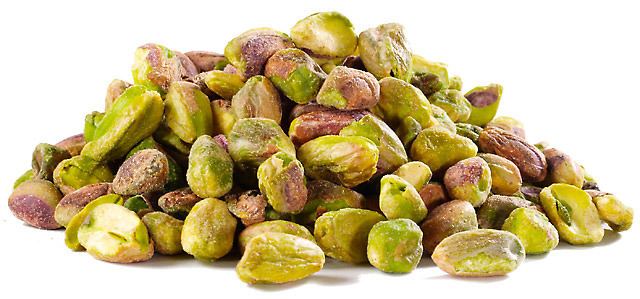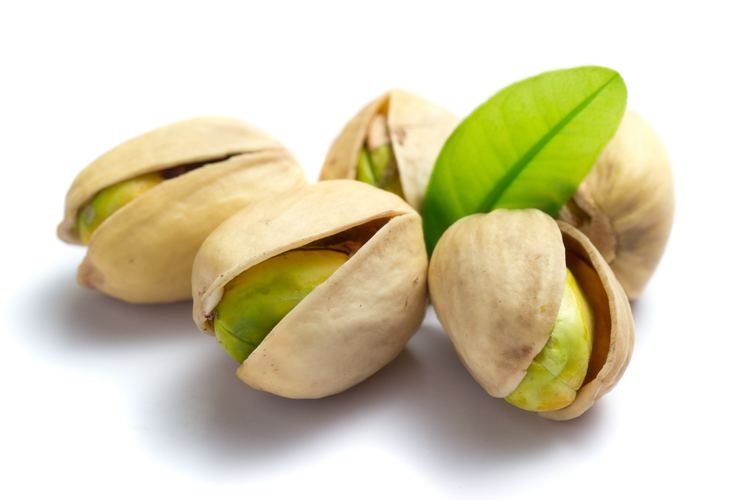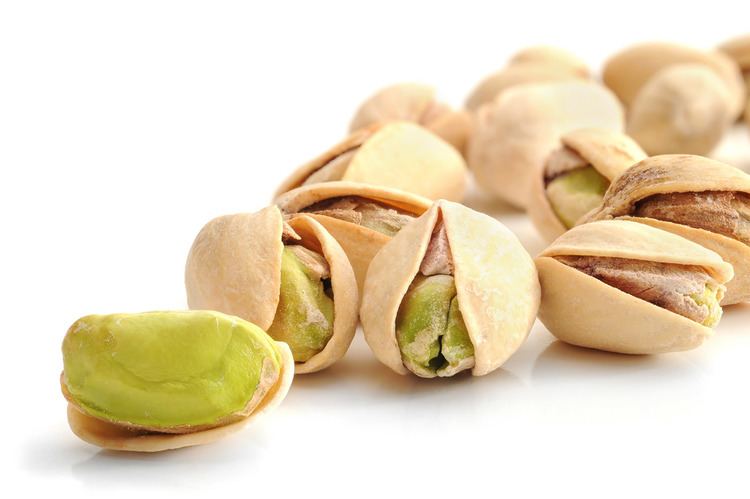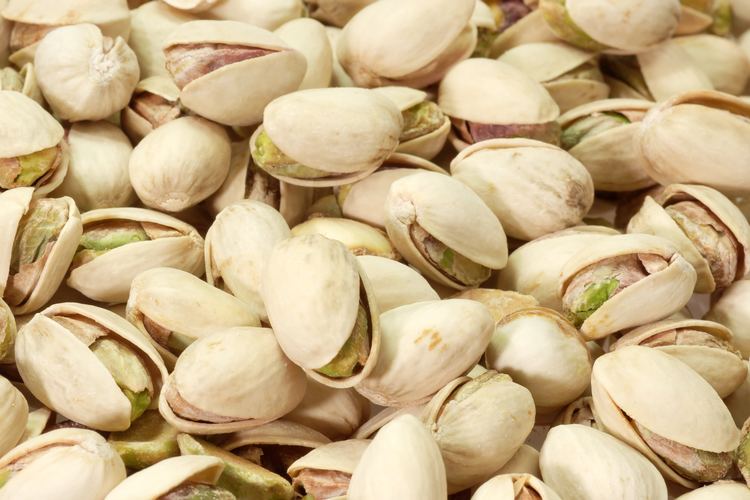Species P. vera | ||
 | ||
Similar Almond, Cashew, Nut, Walnut, Hazelnut | ||
The pistachio (/pɪˈstɑːʃiˌoʊ, -ˈstæ-/, Pistacia vera), a member of the cashew family, is a small tree originating from Central Asia and the Middle East. The tree produces seeds that are widely consumed as food.
Contents
- How pistachio nuts are harvested and processed
- History
- Habitat
- Characteristics
- Cultivation
- Diseases and environment
- Production
- Consumption
- Nutritional information
- Research and health effects
- Toxin and safety concerns
- References

Pistacia vera often is confused with other species in the genus Pistacia that are also known as pistachio. These other species can be distinguished by their geographic distributions (in the wild) and their seeds which are much smaller and have a soft shell.

How pistachio nuts are harvested and processed
History

Archaeology shows that pistachio seeds were a common food as early as 6750 BC. Pliny the Elder writes in his Natural History that pistacia, "well known among us", was one of the trees unique to Syria, and that the seed was introduced into Italy by the Roman Proconsul in Syria, Lucius Vitellius the Elder (in office in 35 AD) and into Hispania at the same time by Flaccus Pompeius. The early sixth-century manuscript De observatione ciborum ("On the observance of foods") by Anthimus implies that pistacia remained well known in Europe in Late Antiquity. Archaeologists have found evidence from excavations at Jarmo in northeastern Iraq for the consumption of Atlantic pistachio. The Hanging Gardens of Babylon were said to have contained pistachio trees during the reign of King Merodach-Baladan about 700 BC.

The modern pistachio P. vera was first cultivated in Bronze Age Central Asia, where the earliest example is from Djarkutan, modern Uzbekistan. It appears in Dioscurides as pistakia πιστάκια, recognizable as P. vera by its comparison to pine nuts.

Additionally, remains of the Atlantic pistachio and pistachio seed along with nut-cracking tools were discovered by archaeologists at the Gesher Benot Ya'aqov site in Israel's Hula Valley, dated to 780,000 years ago. More recently, the pistachio has been cultivated commercially in many parts of the English-speaking world, in Australia, and in New Mexico and California, of the United States, where it was introduced in 1854 as a garden tree. David Fairchild of the United States Department of Agriculture introduced hardier cultivars collected in China to California in 1904 and 1905, but it was not promoted as a commercial crop until 1929. Walter T. Swingle’s pistachios from Syria had already fruited well at Niles, California, by 1917.
The earliest records of pistachio in English are around roughly year 1400, with the spellings "pistace" and "pistacia". The word pistachio comes from medieval Italian pistacchio, which is from classical Latin pistacium, which is from ancient Greek pistákion and pistákē, which is generally believed to be from Middle Persian, although unattested in Middle Persian. Later in Persian, the word is attested as pesteh. As mentioned, the tree came to the ancient Greeks from Western Asia.
Habitat
Pistachio is a desert plant, and is highly tolerant of saline soil. It has been reported to grow well when irrigated with water having 3,000–4,000 ppm of soluble salts. Pistachio trees are fairly hardy in the right conditions, and can survive temperatures ranging between −10 °C (14 °F) in winter and 48 °C (118 °F) in summer. They need a sunny position and well-drained soil. Pistachio trees do poorly in conditions of high humidity, and are susceptible to root rot in winter if they get too much water and the soil is not sufficiently free-draining. Long, hot summers are required for proper ripening of the fruit. They have been known to thrive in warm, moist environments.
Characteristics
The bush grows up to 10 m (33 ft) tall. It has deciduous pinnate leaves 10–20 centimeters (4–8 inches) long. The plants are dioecious, with separate male and female trees. The flowers are apetalous and unisexual, and borne in panicles.
The fruit is a drupe, containing an elongated seed, which is the edible portion. The seed, commonly thought of as a nut, is a culinary nut, not a botanical nut. The fruit has a hard, creamish exterior shell. The seed has a mauvish skin and light green flesh, with a distinctive flavor. When the fruit ripens, the shell changes from green to an autumnal yellow/red, and abruptly splits part way open (see photo). This is known as dehiscence, and happens with an audible pop. The splitting open is a trait that has been selected by humans. Commercial cultivars vary in how consistently they split open.
Each pistachio tree averages around 50 kilograms (110 lb) of seeds, or around 50,000, every two years.
The shell of the pistachio is naturally a beige color, but it is sometimes dyed red or green in commercial pistachios. Originally, dye was applied by importers to hide stains on the shells caused when the seeds were picked by hand. Most pistachios are now picked by machine and the shells remain unstained, making dyeing unnecessary except to meet ingrained consumer expectations.
Cultivation
The trees are planted in orchards, and take approximately seven to ten years to reach significant production. Production is alternate-bearing or biennial-bearing, meaning the harvest is heavier in alternate years. Peak production is reached around 20 years. Trees are usually pruned to size to make the harvest easier. One male tree produces enough pollen for eight to 12 drupe-bearing females. Harvesting in the United States and in Greece is often accomplished using equipment to shake the drupes off the tree. After hulling and drying, pistachios are sorted according to open-mouth and closed-mouth shells. Sun-drying has been found to be the best method of drying, then they are roasted or processed by special machines to produce pistachio kernels.
In Greece, the cultivated type of pistachios has an almost-white shell, sweet taste, a red-green kernel and a closed-mouth shell relative to the 'Kerman' variety. Most of the production in Greece comes from the island of Aegina, the region of Thessaly-Almyros and the regional units of West Attica, Corinthia and Phthiotis.
In California, almost all female pistachio trees are the cultivar 'Kerman'. A scion from a mature female 'Kerman' is grafted onto a one-year-old rootstock.
Bulk container shipments of pistachio kernels are prone to self-heating and spontaneous combustion because of their high fat and low water contents.
Diseases and environment
Pistachio trees are vulnerable to numerous diseases. Among these is infection by the fungus Botryosphaeria, which causes panicle and shoot blight (symptoms include death of the flowers and young shoots), and can damage entire pistachio orchards. In 2004, the rapidly growing pistachio industry in California was threatened by panicle and shoot blight first discovered in 1984. In 2011, anthracnose fungus caused a sudden 50% loss in the Australian pistachio harvest. Several years of severe drought in Iran around 2008 to 2015 caused significant declines in production.
Production
In 2014, Iran and the United States were the major producers of pistachios, together accounting for 76% of the total world production (table).
Consumption
The kernels are often eaten whole, either fresh or roasted and salted, and are also used in pistachio ice cream, kulfi, spumoni, historically in Neapolitan ice cream, pistachio butter, pistachio paste and confections such as baklava, pistachio chocolate, pistachio halva, pistachio lokum or biscotti and cold cuts such as mortadella. Americans make pistachio salad, which includes fresh pistachios or pistachio pudding, whipped cream, and canned fruit.
Nutritional information
Pistachios are a nutritionally dense food. In a 100 gram serving, pistachios provide 562 calories and are a rich source (20% or more of the Daily Value or DV) of protein, dietary fiber, several dietary minerals and the B vitamins, thiamin and especially vitamin B6 at 131% DV (table). Pistachios are a good source (10–19% DV) of calcium, riboflavin, vitamin B5, folate, vitamin E , and vitamin K (table).
The fat profile of raw pistachios consists of saturated fats, monounsaturated fats and polyunsaturated fats. Saturated fatty acids include palmitic acid (10% of total) and stearic acid (2%). Oleic acid is the most common monounsaturated fatty acid (51% of total fat) and linoleic acid, a polyunsaturated fatty acid, is 31% of total fat. Relative to other tree nuts, pistachios have a lower amount of fat and calories but higher amounts of potassium, vitamin K, γ-tocopherol, and certain phytochemicals such as carotenoids and phytosterols.
Research and health effects
In July 2003, the United States' Food and Drug Administration (FDA) approved the first qualified health claim specific to seeds lowering the risk of heart disease: "Scientific evidence suggests but does not prove that eating 1.5 ounces (42.5 g) per day of most nuts, such as pistachios, as part of a diet low in saturated fat and cholesterol may reduce the risk of heart disease". Although pistachios contain many calories, epidemiologic studies have provided strong evidence that their consumption is not associated with weight gain or obesity.
A 2015 systematic review and meta-analysis of randomized controlled trials concluded that pistachio consumption in persons without diabetes mellitus appears to modestly lower systolic and diastolic blood pressure. Several mechanisms for pistachios' antihypertensive properties have been proposed. These mechanisms include pistachios' high levels of the amino acid arginine (a precursor of the blood vessel dilating compound nitric oxide); high levels of phytosterols and monounsaturated fatty acids; and improvement of endothelial cell function through multiple mechanisms including reductions in circulating levels of oxidized low density lipoprotein cholesterol and pro-inflammatory chemical signals.
Toxin and safety concerns
As with other tree seeds, aflatoxin is found in poorly harvested or processed pistachios. Aflatoxins are potent carcinogenic chemicals produced by molds such as Aspergillus flavus and Aspergillus parasiticus. The mold contamination may occur from soil, poor storage, and spread by pests. High levels of mold growth typically appear as gray to black filament-like growth. It is unsafe to eat mold-infected and aflatoxin-contaminated pistachios. Aflatoxin contamination is a frequent risk, particularly in warmer and humid environments. Food contaminated with aflatoxins has been found as the cause of frequent outbreaks of acute illnesses in parts of the world. In some cases, such as Kenya, this has led to several deaths.
Pistachio shells typically split naturally prior to harvest, with a hull covering the intact seeds. The hull protects the kernel from invasion by molds and insects, but this hull protection can be damaged in the orchard by poor orchard management practices, by birds, or after harvest, which makes it much easier for pistachios to be exposed to contamination. Some pistachios undergo so-called "early split", wherein both the hull and the shell split. Damage or early splits can lead to aflatoxin contamination. In some cases, a harvest may be treated to keep contamination below strict food safety thresholds; in other cases, an entire batch of pistachios must be destroyed because of aflatoxin contamination. Pistachio shells may be helpful in cleaning up pollution created by mercury emissions.
Like other members of the Anacardiaceae family (which includes poison ivy, sumac, mango, and cashew), pistachios contain urushiol, an irritant that can cause allergic reactions.
